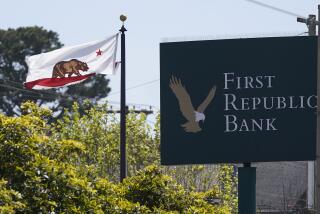More Money Needed to Close Ailing S&Ls;, Congress Panel Told
- Share via
WASHINGTON — The top federal savings and loan regulator said today that unless Congress and the Administration come up with more money to resolve the industry’s crisis, his agency may have to leave hundreds of insolvent institutions open.
“The legislative failure to provide additional resources in a timely fashion would place the (Federal Home Loan) Bank Board in a position where there is no other option but to cease case resolutions,” M. Danny Wall, chairman of the bank board, told the House Budget Committee.
The bank board last year spent $38 billion to close insolvent institutions or merge them with healthier partners.
$2.5 Billion a Year Losses
Wall estimated that insolvent savings and loans are losing $2.5 billion a year. The bank board has estimated that it will cost $45 billion to $50 billion to clean up the industry. Private estimates run to $100 billion or more.
Wall said the bank board will provide an updated cost estimate, possibly next week.
He said to “permit weak institutions to continue to deteriorate . . . would ultimately increase the cost of resolution.”
In separate testimony before the committee, Federal Deposit Insurance Corp. Chairman L. William Seidman said FDIC funds should not be used to rescue insolvent thrifts.
“It would be unfair to target banks to pay the cost of rescuing their competitors, the S&L; industry,” Seidman said.
The FDIC, which insures deposits at banks, has estimated the cost of recapitalizing the Federal Savings and Loan Insurance Corp., the branch of the FHLBB that insures thrifts against insolvency, could range between $80 billion and $105 billion, Seidman said.
“Unfortunately, one way or another, the federal government will have to provide some of the funding to resolve the FSLIC problem either through use of its credit, revenues or user fees,” Seidman said.
Wall said it was unrealistic to expect the thrift industry to shoulder the entire burden of bailing out the remaining insolvent thrifts.
He said any decision regarding additional funds for FSLIC should be made by the Bush Administration and by Congress. If significant amounts of cash became available, regulators could pursue several possible courses, Wall added.
For example, he said it would be cheaper for FSLIC to purchase certain insured assets from buyers of insolvent thrifts and recognize the losses quickly rather than continue to pay an annual yield on the asset over the life of a rescue agreement.
In a second course of action, FSLIC could buy back some of its promissory notes, Wall said, noting that in some cases the interest that the fund pays is substantially higher than the income received on FSLIC investments.
In another approach, additional cash for FSLIC would allow acquired institutions that have profit-sharing arrangements with FSLIC to pay off high-cost debt, which would improve their earnings and thus benefit FSLIC.
More to Read
Inside the business of entertainment
The Wide Shot brings you news, analysis and insights on everything from streaming wars to production — and what it all means for the future.
You may occasionally receive promotional content from the Los Angeles Times.










